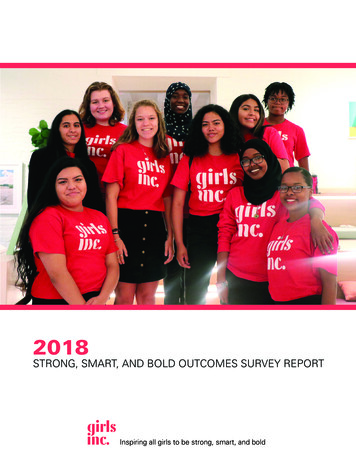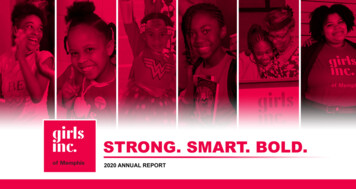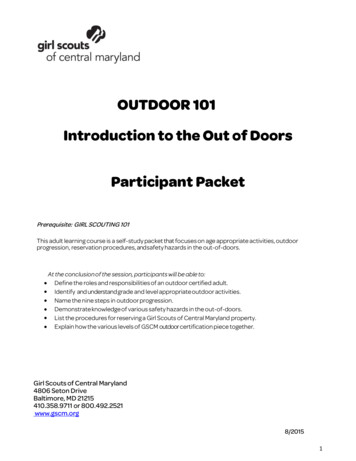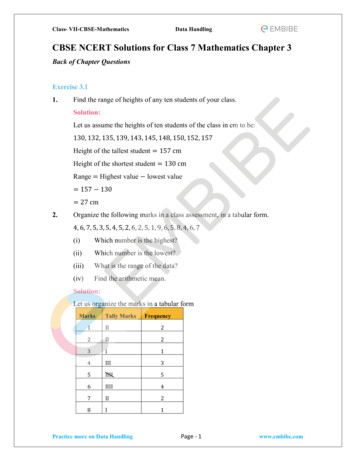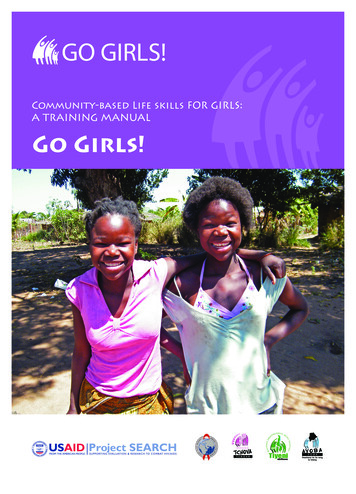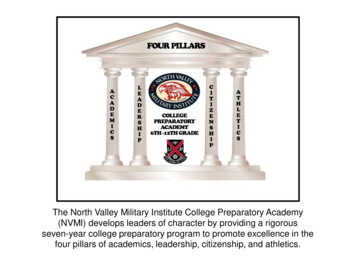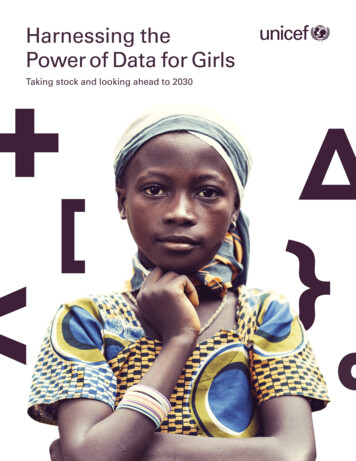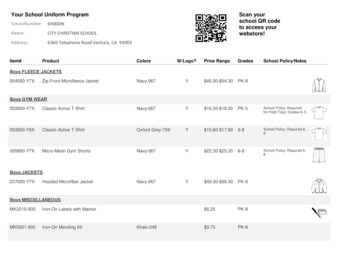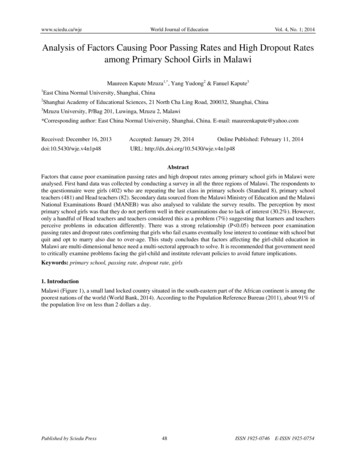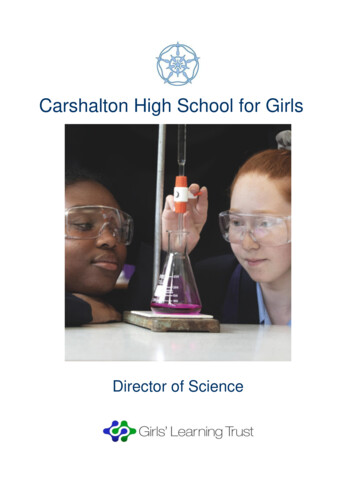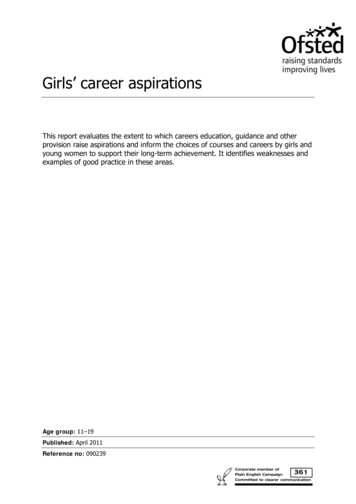
Transcription
Girls’ career aspirationsThis report evaluates the extent to which careers education, guidance and otherprovision raise aspirations and inform the choices of courses and careers by girls andyoung women to support their long-term achievement. It identifies weaknesses andexamples of good practice in these areas.Age group: 11–19Published: April 2011Reference no: 090239
The Office for Standards in Education, Children's Services and Skills (Ofsted) regulates and inspects toachieve excellence in the care of children and young people, and in education and skills for learners ofall ages. It regulates and inspects childcare and children's social care, and inspects the Children andFamily Court Advisory Support Service (Cafcass), schools, colleges, initial teacher training, work-basedlearning and skills training, adult and community learning, and education and training in prisons andother secure establishments. It assesses council children’s services, and inspects services for lookedafter children, safeguarding and child protection.If you would like a copy of this document in a different format, such as large print or Braille, pleasetelephone 0300 123 1231, or email enquiries@ofsted.gov.uk.You may reuse this information (not including logos) free of charge in any format or medium, underthe terms of the Open Government Licence. To view this licence, nt-licence/, write to the Information Policy Team,The National Archives, Kew, London TW9 4DU, or email: psi@nationalarchives.gsi.gov.uk.This publication is available at: www.ofsted.gov.uk/publications/090239.To receive regular email alerts about new publications, including survey reports and school inspectionreports, please visit our website and go to ‘Subscribe’.Royal Exchange BuildingsSt Ann’s SquareManchesterM2 7LAT: 0300 123 1231Textphone: 0161 618 8524E: enquiries@ofsted.gov.ukW: www.ofsted.gov.ukNo. 090239 Crown copyright 2011
ContentsExecutive summary4Key findings5Recommendations5The national context6The survey structureWhat girls know about future careersThe quality of advice and guidanceExternal influencesCareers and the curriculumExtending the curriculum – examples of good practicePartnerships with employers771013141921Notes22Further informationPublications by OfstedOther publications232324Annex: Providers visited for this survey25
Executive summaryYoung women achieve better educationally than boys at the age of 16. A higherproportion of girls than boys continue in education to degree level. Their earlysuccess, however, does not translate into similar advantages in terms of careers andpay in later life. Women are also less likely than men to work in certain sectors suchas science, engineering and technology.This small scale survey looked at the choices of courses and careers made by girlsand young women at various stages in their education and training. Between June2009 and December 2010 inspectors visited 16 primary schools, 25 secondaryschools, (including 13 single-sex girls’ schools) and 10 further education colleges.Inspectors also contacted 36 businesses linked to 12 schools. Inspectors found thatfrom Year 3 onwards, the girls spoken to were thinking about what they would liketo do after they left school. For girls of all ages, this thinking was strongly influencedby family and friends. These girls were aware of the conventions surrounding ‘girls’jobs’ and ‘boys’ jobs’. By secondary school they could also articulate reasons whythey could, should they wish, choose any kind of job irrespective of tradition. Almostall the girls and young women who took part in the survey were open to thepossibility of pursuing a career that challenged gender stereotypes, if the careerinterested them sufficiently. Their awareness of this potential, however, did notalways translate into practice. Course and career choices made by the girls andyoung women, in the schools and colleges visited, were predominantly stereotypicaland mirrored the national picture of take-up of courses.Careers education was generally weak in Key Stage 3. This made informed choices ofcourses and careers difficult. In particular, the girls spoken to had only limitedknowledge and understanding of how their choices influenced their future pay andprogression. Eleven of the 12 mixed schools visited were not doing enough topromote the confidence, drive and ambition of girls and young women to take risksin challenging vocational stereotypes. While the 13 all-girl schools said thatconfidence and competitive attitudes were easier to promote in the absence of boys,it was still the case that the proportion of girls’ entries for individual GCSE and Alevel subjects in these schools broadly matched the national profile of examinationentries by girls.In the few examples where girls had changed their minds and set out on a new andunfamiliar route, that change had often been catalysed by a personal experience ofeither meeting a professional in school, or directly encountering the new kind ofwork for themselves. That could happen accidentally, for example as part of a schooltrip that captured an individual’s imagination, or deliberately through school-directedwork placements designed to challenge preconceptions.Inspectors also found good examples of ways in which the specialist status schoolsvisited engaged with employers. In these cases, the schools used their specialiststatus to present broader career pathways to young women and to develop theirknowledge, skills and attitudes.4Girls’ career aspirationsApril 2011, No. 090239
Key findings From an early age, the girls surveyed had held conventionally stereotypical viewsabout jobs for men and women. They retained those views throughout theirschooling despite being taught about equality of opportunity and knowing theirrights to access any kind of future career. The programmes of careers education and work-related learning, and theprovision of information, advice and guidance in the schools visited, were notfocused sufficiently on the knowledge, understanding and skills that girls andyoung women needed in order to deal with factors such as career breaks and theroles they might wish to play as future parents. A narrow range of gender-stereotypical work placements dominated choices inalmost all the settings seen. The girls and young women spoken to had limited knowledge and understandingof how choices about courses and careers influenced pay and progression routes. Even in the all-girls’ schools visited for this survey, and despite the rich range ofawareness-raising activities across all the schools, most girls chose careers alongstereotypical lines. For a few girls, career ambitions were changed through direct observation of aprofessional at work, through mentoring activities, and through personalencounters and extended discussion with a professional about what their job wasactually like.RecommendationsSchools and colleges should: ensure that young people have a better understanding about career choice,subsequent progression and its impact on their long-term earnings assist young people in developing an understanding of the responsibilitiesand choices associated with parenthood develop better, and more carefully planned opportunities for young womento meet professionals working in non-stereotypical roles, and to learn moreabout what such work entails strengthen the knowledge and understanding of staff about the wide rangeof progression routes available so that girls and young women can makeinformed choices consider how to link the content of lessons and the skills to be developedmore frequently to career opportunities consider ways in which mentoring could be used to help support youngwomen in overcoming barriers to achievement.Girls’ career aspirationsApril 2011, No. 0902395
The national context1.Young women have better educational outcomes than boys at the age of 16and a higher proportion of young women continue their education to degreelevel. More women have higher educational qualifications than men up to theage of 44.1 This success in educational terms, however, does not translate intosimilar advantages in terms of long-term career status and pay.2.Despite the Equal Pay Act (1970) and Sex Discrimination Act (1975), womenhave continued to earn less on average than men, although recent evidencesuggests that women are now earning more than men between the ages of 22and 29. The gender gap in favour of men is greatest among older workers, ataround 17% for the 50–59 age bracket. There are differences in these figuresbetween public and private sectors, between full-time and part-time workers,and between different occupational groups.23.In 2006 the Women and Work Commission concluded that women are crowdedinto a narrow range of lower-paying occupations that do not make the best useof their skills.3 Women are also less likely than men to work in certain sectorssuch as science, engineering and technology, although that may not have adirect bearing on initial earnings. In 2009, the National Skills Forum reportedthat increasing the range and level of women’s skills would help to combat theUK’s skills deficit, improve UK productivity and reduce the gap in pay andopportunities between men and women.44.In post-16 courses, there has been a slow shift in some subjects towardsgender balance. For example, in 2000, 38% of A-level mathematics candidateswere girls, rising to 40% in 2010. In 2000, 28% of entries in technology weregirls, rising to 44% in 2010. But the proportion of girls taking physics fell slightlyfrom 23% to 21% in the same period. In contrast, 56% of entries for biologicalsciences were girls, and 48% of entries for Chemistry were girls, so thesesubjects were essentially free of stereotypical choice bias.5 This survey checkedA-level uptake in sixth forms where possible and looked for relationshipsbetween school specialism and A-level uptake.1An anatomy of economic inequality in the UK, report of the National Equality Panel (ISSN 14653001), Government Equalities Office, 2010;www.equalities.gov.uk/national equality panel/publications.aspx.2Office for National Statistics, earnings analysis, 21 December 2010;www.statistics.gov.uk/cci/nugget.asp?id 167.3Shaping a fairer future, Women and Work Commission, 2006; Closing the gender skills gap, National Skills Forum, February E/Applied GCE A/AS and Equivalent Examination Results in England, 2009/10 (Revised),Department for Business Innovation and Skills, /index.shtml.6Girls’ career aspirationsApril 2011, No. 090239
The survey structure5.The survey set out to evaluate the extent to which careers education, guidanceand other facilities provided by schools and further education colleges raisedaspirations and informed girls’ and young women’s choices of courses andcareers, to support their long-term achievement.6.Much of the information gathered during the survey came from discussions withpupils and students themselves, coupled with information from some providersrelating to transition between phases, and destination data beyond school. Inthe primary schools visited, inspectors spoke to mixed groups of Year 3 pupilsand separate groups of Year 6 boys and girls. In the secondary schools,discussions were held with girls in different age groups, up to Year 12.Inspectors also visited 10 further education colleges, selected because they hadtargeted areas of provision specifically for girls and young women.What girls know about future careersThe views of primary school pupils7.Primary pupils taking part in the survey already had established views on work‘roles’ and quite stereotypical personal opinions even though they knew inprinciple that any job is possible, irrespective of gender. They held clear viewsof what might be considered ‘boys’ or ‘girls’ jobs although, after some gentleprompts, most admitted that they could do either, in principle. But almost to apupil, the girls spoken to would not countenance actually taking up a role theyassociated with males, for example plumbing, ‘because it is so messy and boyslike mess’. Both boys and girls had considerable difficulty coping with theconcept of a boy being a nursery nurse, however theoretically possible theyadmitted that it could be.8.In discussion about what they would like to do for a job, the youngest pupilstalked about wanting to become teachers or vets (girls), footballers or pilots(boys). The Year 6 girls interviewed had a wider idea of what they might like todo with some already talking of science alongside nursing, teaching, police,armed services, care services, hairdressing and beauty work. Boys continued toprefer sports or applied technology vocations, a games designer being apopular notion. Around half (51 out of 112) of the Year 6 boys spoken to werethinking of these two areas. In contrast, only four of the 113 girls surveyedreferred to sport (horse riding and gymnastics) while 43 were aiming atperforming or graphic arts, or writing. Only five girls and six boys had nodefinite thought about a future job. No Year 6 pupil, girl or boy, wanted to be anursery nurse or childminder although they all thought that these were ‘girlsjobs’.9.Most of the primary school pupils surveyed had family or friends connected tothe jobs they were considering. They had no clear understanding, however, ofthe necessary qualifications for their preferred roles, or of how qualificationsGirls’ career aspirationsApril 2011, No. 0902397
are structured through different levels. Most gave inspectors the impression ofconsidering such matters for the first time during the focus groups. Theyoffered essentially stereotypical reasons for why men earn more than women.For example, one pupil captured the general thinking of staff as much as pupilswhen she suggested, ‘Girls can do anything. But most managers are men; boyswant power more than girls.’ Another said, ‘girls have more to think aboutwhen going for a job. Men are more single minded on a career’. Anotherthought that ‘people don’t want women as leaders’.10. Most of the girls spoken to said that they considered having an interesting jobto be more important than the salary. About half of the 113 Year 6 girls hadchanged their minds about a future job, compared with when they wereyounger. They had moved on from teaching and working with animals toconsider a wider range of possibilities, usually because of knowing a persondoing that job, being involved in a club outside school such as music or drama,or in exceptional cases, seeing for themselves that work in action because of aschool or family trip.The views of secondary school pupils11. In all but three of the secondary schools visited, the girls interviewed at KeyStage 3 spoke of their general awareness of future careers. Most of them couldrecall activities and events in which they had taken part, such as a commercialgame which involved looking at random jobs and managing money, althoughthey were unable to recall any key messages from the exercise. They made thepoint that the exercise was not personalised to job choices that were relevantto them.12. Girls of all ages in the secondary schools visited were able to distinguishbroadly between higher-paid and low-paid jobs. They correctly linked additionaltraining and higher skills to higher-paid jobs but frequently over-estimated thesalary of those working in the early years and care sectors. Girls enjoyed theopportunity to discuss different jobs and relative pay with inspectors and saidthey found this valuable and informative. All but two of the schools did nothave a specific strategy which encouraged young women to consider longerterm job prospects and pay, although there were exceptions. For example, inone school visited, the young women spoken to referred to a ‘Real Money’exercise, provided by their school, which they had found very useful in settingpay against bills and lifestyle choices. They felt, however, that the input wouldhave been more valuable earlier on in school. They recognised that havingmore financial information would better support them to make informed careerchoices.13. Almost all the secondary school girls who spoke to inspectors were open to thepossibility of pursuing a career that challenged stereotypes, if the jobs lookedinteresting. Their schools had successfully ensured that their studentsunderstood that some career options were associated with stereotyping andthat such views can be challenged. In one setting, however, girls’ attitudes8Girls’ career aspirationsApril 2011, No. 090239
were more entrenched; one Year 8 girl said, ‘We are not meant to do men’sjobs like building.’ A few girls in this school expressed concern about possibleunfair treatment in a predominantly male environment. Girls in the mixedschools’ focus groups felt that they needed more information to broaden theirview of what jobs were possible.14. The most positive attitudes were found in the single-sex schools visited, wheremost of the girls spoken to asserted that they would definitely consider jobsstereotypically done by men. The girls in the selective secondary schools didnot view any career as being unavailable to them, as long as they worked hardand achieved the relevant qualifications. They understood that this was integralto the changing roles of women and they felt that more women should beencouraged into roles traditionally done by men. However, this confidentthinking, strongly championed by teachers and school leaders, was notmatched by any noticeable shift away from gender-typical course or careerchoices. Almost all of these girls told inspectors that they were not planning topursue such a route for themselves.15. Inspectors asked Year 7, Year 10 and sixth form girls from the schools visitedwhat career path they were considering; in all three age groups about a quarterof the 200 girls questioned were considering a health service route, witheducation and performing arts the next most popular. Only seven of the girlswere considering engineering and 17 a science-related career. None werelooking to construction-related trades. The girls’ thoughts about future careersremained very similar across all three age ranges, in all types of school. Formost of the girls spoken to, including the sixth formers, the major influence ontheir thoughts about careers remained that of family and friends. Typically, theywere thinking of careers very similar to their families, either parents or siblings.The influence of school, or of explicit careers education, was relatively small.The information from families, however, did not usually extend to details aboutsalary, career structure, or promotional prospects. Options programmes in Year9 and guidance lessons were seen as helpful in making choices about courses,although links with careers were less explicit.16. The girls in the secondary school sample were asked to reflect on concerns thatthey or their parents might have if they were to take up a less stereotypicalcareer path. Most were very confident and did not see any barriers. A typicalresponse was: ‘You should not be judged by your gender or should not betreated differently.’ All the groups spoken to knew of their right to expect equalopportunities and that women should receive equal pay to men for doing thesame job. Responses about entering male-dominated occupations, however,were more tentative. For example, comments such as ‘there may bediscrimination’ or ‘it could be intimidating’ were commonplace from girls whoresponded to questions about what they thought might happen if theyattempted to enter such an occupation. In these cases, the girls suggested theywould want to visit the working environment and see a woman doing the jobsuccessfully before choosing it for themselves.Girls’ career aspirationsApril 2011, No. 0902399
17. Inspectors asked the girls for their opinion about why there was a pay gapbetween men and women. Their responses generally reflected common, anddeeply held, views. For example, many of the older girls in the single-sexschools suggested that men were ‘more competitive’ and ‘motivated by power’,compared with women. They thought money was not the only consideration,pointing out the view that women were more likely to take time out of work toraise families. As one young woman put it, ‘women have to compromisebetween work and family it is supposed to be moving on but it is still womenthat have to make the sacrifice’. Another said, ‘having children puts employersoff appointing women’. Some young women also said that to ‘get on’ inleadership and management, girls had to be ‘aggressive, forceful, persistentand selfish’. They thought that was why women did not pursue careers in highfinance or business.18. Almost all the young women spoken to from the school sixth forms visited saidthat they would consider a wide range of careers, although, in practice, theywere usually following a narrower range of routes. A few were concerned aboutthe language used in the workplace and the potential attitude of men,expressed in phrases such as, ‘Women can’t do this work.’ Most of the youngwomen, however, were very assertive; they wanted to prove men wrong bychallenging stereotypes. They were concerned about the possibility that theymight be pre-judged because they were female but felt that this would increasetheir determination to prove themselves and gain new experience.The quality of advice and guidance19. The primary schools taking part in the survey did not deliver explicit careersadvice in the sense of informing pupils about the qualifications and skillsneeded to perform particular jobs. What they all did, however, was aim tomaximise basic skills, including in several cases explicit approaches toimproving communication skills, teamworking, writing, and problem-solving.The pupils spoken to at Key Stage 2 had increased their awareness ofstereotyping and the potential for girls and boys to do any kind of job; thissuggests that some notions about stereotyping and employment rights havebeen transmitted effectively by some means, although not necessarilyintentionally. However, for those girls taking part in the survey, theirinformation relating to careers came overwhelmingly from home and family andnot the school.20. In all the examples where primary schools were associated with a localspecialist secondary school, either by proximity or through transitionarrangements, good partnerships existed which involved drawing on expertisefrom that school and exchange visits for pupils and staff. In essence, however,these were accidental arrangements, rather than systematic; the exchange ofspecialist expertise depended on what the secondary school happened to haveavailable rather than being a response to pupil need. In terms of providing rolemodels that challenged stereotypes, these partnerships, where they existed,10Girls’ career aspirationsApril 2011, No. 090239
appeared to be effective. Inspectors found several examples of female scienceand mathematics specialists and male performing arts experts meeting andworking with pupils.21. The primary school headteachers spoken to expressed a general concern thatthe information they possessed about a pupil’s talents, ambitions, interests andcircumstances was not making much difference to the work of the receivingsecondary school. Although they felt that the ‘event’ of transition was wellmanaged in terms of the pastoral care and initial settling-in, they were notconvinced that the receiving schools took much notice of individual pupils’attainment, let alone interests, across the full range of subjects. There was littleevidence, other than anecdotal comments from former pupils, of primaryschools seeking feedback from their ex-pupils.22. Data showed that, in the sample of schools visited, girls chose courses at KeyStage 4 and sixth form in similar proportions to girls in similar schoolsnationally. Although there were no systematic school-based strategies tochallenge those choices, school staff said they ‘encouraged’ girls to considernon-stereotypical routes and supported them if they made such a choice.23. Where numbers in a particular curriculum area were high, this situation oftenbut not always, correlated strongly with a specialist school’s curriculumspecialism and was in line with its course take-up targets. However, this couldwork for or against stereotypical choices. For example, one girls’ school with anarts specialism entered a higher than average proportion (for girls nationally)for GCSE art and design, and drama but had no-one taking GCSE businessstudies at Key Stage 4. There was also a very low proportion of studentsstudying design technology.24. Other influences can promote curriculum emphasis alongside specialism. Forexample, in a school with specialisms in music and applied learning, 94% ofgirls studied design technology at Key Stage 4, driven by the (female) deputyheadteacher’s enthusiasm for technology. In that school an unusually highproportion of girls continued studying technology at A level and the school’sdestination data showed that five went on to study for engineering degrees.25. In contrast, a specialist science and mathematics girls’ school also had highproportions of GCSE entries for art, business studies, drama and sport but lowproportions for design and technology. Two of the all-girls’ schools visited sawparticipation in Diploma courses in information technology and engineering asan opportunity to challenge stereotypical roles and careers. However, thechoice of Diploma subjects was frequently along traditional gender lines andthere was insufficient focus on advice and guidance around this issue.26. Choices made by the young women seen who attended college as part of theKey Stage 4 curriculum also remained strongly stereotypical. Typically, oneyoung woman in Year 10 told inspectors, ‘New subjects are not familiar enoughso we go with what we are good at in Key Stage 3.’ Another female studentGirls’ career aspirationsApril 2011, No. 09023911
said, ‘There was no taster session for engineering’, suggesting that tastercourses might help to give girls the confidence to try something new. The valueof taster sessions was also identified in Ofsted’s survey on best practice inapprenticeships.627. None of the schools in the survey had systematic records of the ultimateemployment of their former students. Inspectors heard anecdotes of individualsuccesses and examples of former pupils returning to support the careerseducation programme of the school; however, the lack of long-term intelligencemade it difficult for individual schools to adapt their provision better to meet thelonger-term needs of their students. Nobody had asked the question of formerstudents, ‘what could we have done better to support your careerdevelopment?’28. In 11 of the 25 secondary schools visited, girls in Key Stage 3 said they werenot sufficiently well informed to make the choices they needed to make. Explicitteaching about career breaks, the impact of raising a family and how careersdevelop through promotion was rare in all of the schools. Good examples didoccur, usually within subject-specific courses such as business studies;however, the actual nature of what a particular job involved, beyond its entryqualifications, was not well understood. Commonly, girls thought of a job (byname or generic trait) and then used a database to suggest a range of relevantjobs that had similar entry requirements. Hardly any information about startingsalary, promotion prospects and ultimate earning potential was available andgirls had no clear idea what these might be even when they had very detailednotions of what they wanted to do. This was a major shortfall in theinformation available to young people making choices in these schools,irrespective of gender.29. There was considerable variation in the numbers of young women spoken to byinspectors who had attended interviews with a Connexions adviser. For schools,meeting the needs of potentially vulnerable students was the priority in termsof the focus of the information, advice and guidance they provided. Much ofthis work began at the time of Year 9 options; this was evident in the limitedawareness of careers education shown in inspectors’ discussions with girls inYears 8 and 9. Access to specialist careers advisers in Year 9 for the majority ofgirls involved a group session linked to the process of choosing their courses forYears 10 and 11. Access to Connexions advisers in Year 10 ranged from 2% to99% of young women in the schools visited, with one-to-one interviews anuncommon experience. Connexions advisers tended to focus on those in Year11 and in particular, those most at risk of unemployment on leaving school.One view expressed by a few of the young women interviewed was that Year6Learning from the best. Examples of best practice from providers of apprenticeships inunderperforming vocational areas (090225), Ofsted, 2010; www.ofsted.gov.uk/publications/090225.12Girls’ career aspirationsApril 2011, No. 090239
11 was ‘too late’. One young woman commented: ‘The interview was more ofan event than part of a process.’30. Almost all of the 193 young women interviewed in the colleges visited felt thattheir previous careers education had had very little impact in terms of informingthem about career choices and their future economic prospects. At school, theyhad not been encouraged to consider jobs usually undertaken by men. This wasthe case even for most of the young women who went on to non-stereotypicalcourses, such as engineering or construction. In the colleges visited, aroundthree quarters of the young women interviewed felt that their careersinterviews at school had been unhelpful. Many said that the Connexionsadvisers had asked
The girls and young women spoken to had limited knowledge and understanding of how choices about courses and careers influenced pay and progression routes. Even in the all-girls' schools visited for this survey, and despite the rich range of awareness-raising activities across all the schools, most girls chose careers along
